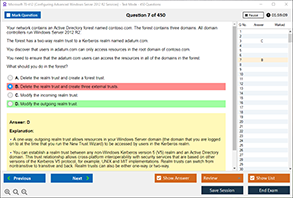Overview of the Cisco 200-301 CCNA Exam
The Cisco 200-301 CCNA (Cisco Certified Network Associate) exam is a foundational-level certification that validates an individual’s knowledge and skills related to network fundamentals, network access, IP connectivity, IP services, security fundamentals, and automation and programmability. It is the go-to certification for those starting their careers in networking and IT infrastructure. The exam is designed to test not only theoretical understanding but also practical application of networking concepts.
The exam includes various domains that are crucial in modern networking environments. These include switching, routing, wireless networking, network security, and more. One such essential concept covered under the security fundamentals section is BPDU Guard, a feature used to protect networks from certain types of misconfigurations and attacks. For those preparing for the Cisco 200-301 exam, understanding BPDU Guard is imperative.
What is BPDU Guard?
Bridge Protocol Data Unit (BPDU) Guard is a security feature used in the Spanning Tree Protocol (STP) environment on Cisco switches. BPDUs are messages exchanged across switches to detect loops and ensure a loop-free topology. In a well-configured network, BPDUs should only be received on interfaces that connect to other switches.
BPDU Guard is designed to protect the integrity of STP by preventing unauthorized devices (such as another switch or a malicious user) from injecting BPDUs into the network. When a port configured with BPDU Guard receives a BPDU, the port is automatically disabled or shut down to prevent potential disruptions or security breaches.
This feature is particularly useful in environments where end-user devices are connected to access ports, and no BPDUs should be expected. By enabling BPDU Guard, network administrators ensure that only trusted devices participate in the STP process.
Network Attack Mitigated by BPDU Guard
BPDU Guard is especially effective in mitigating a class of network attacks known as Spanning Tree Protocol (STP) manipulation attacks. These attacks exploit the dynamic nature of STP to disrupt network operations or gain unauthorized access to network traffic.
One common attack vector is a rogue switch being introduced into the network. An attacker connects a switch to an access port and starts sending BPDUs, attempting to become the root bridge of the network. This manipulation can cause significant changes in network topology, leading to loops, downtime, or even data interception.
Other threats that BPDU Guard helps mitigate include:
-
Man-in-the-Middle (MitM) Attacks: By becoming the root bridge, a rogue device can intercept or manipulate traffic.
-
Denial of Service (DoS) Attacks: Injecting malformed BPDUs can overwhelm the STP process, resulting in unstable network behavior.
-
Network Instability: Frequent topology changes can degrade network performance and cause packet loss or disconnections.
By automatically shutting down ports that receive unexpected BPDUs, BPDU Guard provides a proactive line of defense against these attacks.
How BPDU Guard Mitigates STP Manipulation
BPDU Guard works in tandem with PortFast, a Cisco feature that allows ports to immediately enter a forwarding state, bypassing the usual STP listening and learning states. PortFast is typically enabled on access ports where end-user devices (e.g., PCs, printers) are connected.
When BPDU Guard is enabled on a PortFast-enabled port, the switch monitors the port for any incoming BPDUs. If a BPDU is detected:
-
The port is immediately placed into the error-disabled (err-disabled) state.
-
An SNMP trap or syslog message is generated to alert the network administrator.
-
The port remains disabled until manually re-enabled or automatically recovered, depending on the configuration.
This mechanism prevents potential rogue switches or malicious devices from participating in the STP topology. Since access ports should not receive BPDUs in a properly configured environment, any such BPDU is treated as a potential threat.
Example Configuration:
switch(config)# interface range FastEthernet 0/1 - 24
switch(config-if-range)# spanning-tree portfast
switch(config-if-range)# spanning-tree bpduguard enableThis configuration ensures that all access ports in the specified range are protected by BPDU Guard.
Best Practices for Configuring BPDU Guard
To maximize the security benefits of BPDU Guard, network administrators should follow several best practices:
-
Enable BPDU Guard on All Access Ports: Since these ports should only connect to end devices, they should never receive BPDUs.
-
Combine with PortFast: Use BPDU Guard in conjunction with PortFast to expedite device connectivity while maintaining security.
-
Use Error-Disable Recovery: Configure automatic recovery for ports that enter the error-disabled state to minimize manual intervention.
switch(config)# errdisable recovery cause bpduguard
switch(config)# errdisable recovery interval 300-
Monitor with SNMP and Syslog: Ensure that any BPDU Guard violations are logged and monitored for quick response.
-
Regularly Audit Network Topology: Periodically verify port roles and ensure that unauthorized devices haven’t been connected.
-
User Education and Policy Enforcement: Educate users not to connect unauthorized devices to network ports and enforce policies that prohibit such behavior.
Following these practices helps maintain a stable and secure network environment and prepares candidates for real-world networking challenges.
Exam Relevance: Cisco 200-301
BPDU Guard is a vital topic within the Cisco 200-301 exam’s security fundamentals and network access domains. Candidates are expected to:
-
Understand the function and purpose of BPDU Guard.
-
Recognize scenarios where BPDU Guard should be used.
-
Interpret and configure BPDU Guard settings on Cisco switches.
-
Identify the impact of receiving BPDUs on access ports.
Exam questions may involve theoretical concepts, command-line configurations, or real-world scenarios where the candidate must choose the best security approach.
By mastering BPDU Guard and related features, candidates not only boost their chances of passing the Cisco 200-301 exam but also gain critical skills for securing enterprise networks.
DumpsBoss offers a comprehensive suite of learning tools for the Cisco 200-301 exam, including updated exam dumps, practice questions, and expert-written study guides. These resources help learners understand not just what BPDU Guard is, but how to implement and troubleshoot it in practical scenarios.
Conclusion
BPDU Guard is a powerful feature in Cisco networks that helps secure the STP topology by disabling ports that receive unauthorized BPDUs. It plays a critical role in preventing STP manipulation attacks such as rogue switch insertion, network loops, and man-in-the-middle exploits.
Understanding how BPDU Guard works, how to configure it, and how it fits into the broader network security framework is essential for any aspiring network professional. It is also a crucial topic in the Cisco 200-301 CCNA exam, making it a must-know for certification candidates.
Using DumpsBoss as a preparation platform provides learners with all the tools they need to grasp BPDU Guard and other networking concepts thoroughly. With real-world examples, accurate dumps, and up-to-date study materials, DumpsBoss ensures you're not just ready to pass the CCNA exam—you're ready to thrive in a real networking environment.
Special Discount: Offer Valid For Limited Time “Cisco 200-301 Dumps” Order Now!
Sample Questions for Cisco 200-301 Exam Dumps
Actual exam question from Cisco 200-301 Exam.
Which network attack is mitigated by enabling BPDU Guard?
A) MAC Flooding
B) VLAN Hopping
C) Rogue Switch Attack
D) ARP Spoofing



